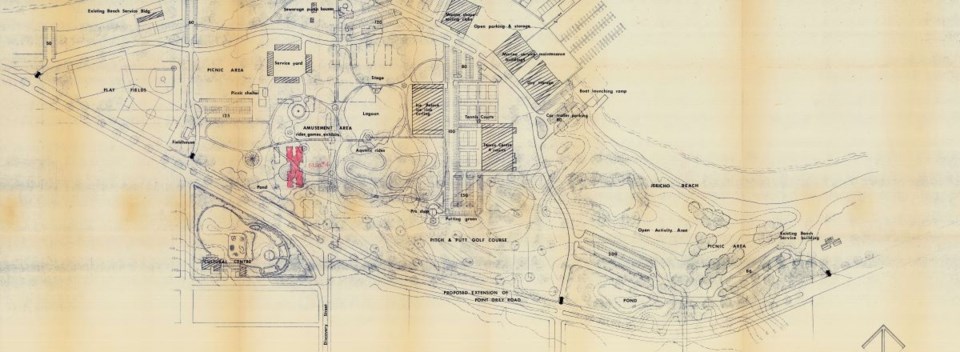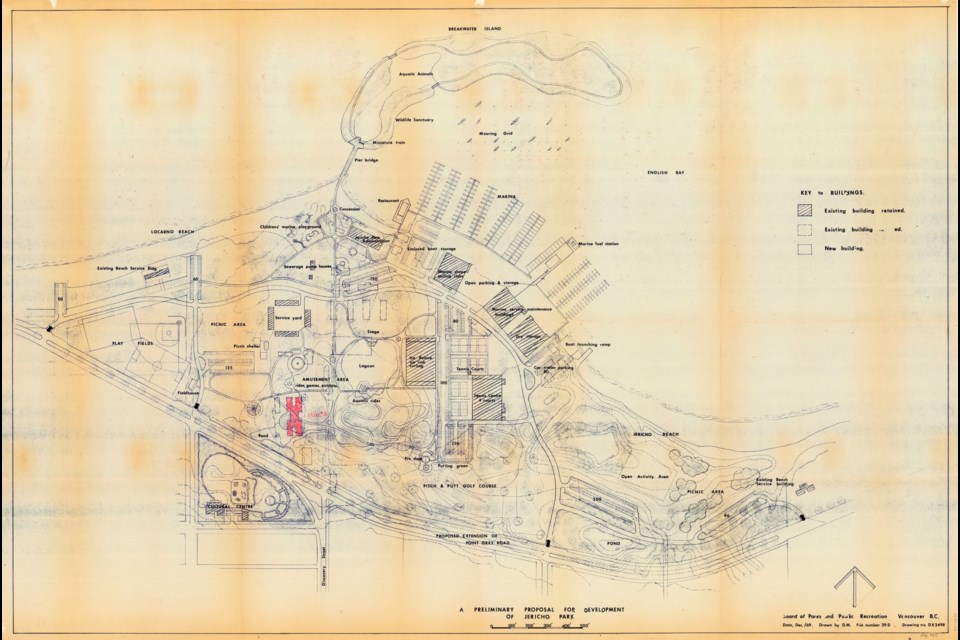There was a time when the Vancouver land now known as Jericho Beach Park was one of the most discussed patches of the city.
While the Jericho Lands south of the park are now home to a high-profile project, the beach and neighbouring land was a hot topic in the early 1970s as its fate was wide open.
One of the biggest proposals suggested a huge project that included an amusement park, an artificial island created for a wildlife sanctuary, a substantial marina, a golf course, and an arena, among other things.
History of the land
While the park may look old and stable, the land there, or at least parts of it, has been a lot of things over the years.
Before colonizers arrived, local First Nations had a settlement there called ʔəy̓ alməxʷ in hən̓q̓əmin̓əm̓, the language of the Musqueam people. When the area began to be settled by Europeans, Jeremiah "Jerry" Rogers logged the area and set up camp at the beach; that's where the name Jericho comes from for the area.
By 1892, a good chunk of the land had been cleared and was turned into the Jericho Golf Club, one of the first golf clubs west of the Mississippi. It significantly changed the landscape of the area.
In 1920, the precursor to the Royal Canadian Air Force set up its first base in B.C. on the beach; at the time seaplanes were a significant part of the aviation world and the shore worked well for the aircraft.
In the 1960s, the federal government planned to give up or sell a sizable portion of the land it controlled there, but to whom and for what wasn't immediately clear, and it was like that for a while. In fact, in 1970 hundreds of "bums" (as the mayor called them) moved in for a while once the military left the barracks.
Proposals
Throughout the late 60s and early 1970s, there was plenty of discussion about what to do with the land between West 4th Avenue and the shore.
One of the early proposals that had support was a huge project that would have seen the park turned into something like a mini Pacific National Exhibition (PNE).
While not the flashiest part of the project, one infrastructure change likely would have had the biggest impact on the area.

The city was considering extending Point Grey Road and expanding it into a six-lane thoroughfare. The road would have cut through what is now parkland and connected to North West Marine Drive where that road arrives at Locarno Beach.
That change would have opened up the area to a lot more traffic, which makes sense when looking at what else was proposed for the site:
- an artificial island with a miniature train and animal sanctuary (slide 1)
- amusement park with rides, games and exhibits (slide 2)
- cultural centre (slide 2)
- ice rink (slide 2)
- stage (slide 2)
- a large marina with amenities like shops, clubs and floating gas station (slide 3)
- a waterfront restaurant (slide 3)
- lagoon (slide 3)
- tennis courts (slide 3)
- putting green/pitch and putt (slide 3)
- children's playground (slide 6)
- sports fields (slide 6)
- ponds
- picnic area
- several parking lots
- a new neighbourhood (not pictured)
The proposed 38-acre park was complex enough that drawings show it would have had its own administrative building.
Keen eyes will see that some of these things do exist at the park in the present-day, like the concession, ponds and tennis courts. There are also facilities for boaters at Jericho Beach as well, but nowhere near the size of what was proposed a half-century ago.
At the same time, while an ice rink sounds like a big project, there were old military buildings on site; many were flagged to be re-purposed, inlcuding one as a rink. As it is, some of the buildings were, in fact, repurposed: they became the hostel and arts centre (though those specific buildings were to be knocked down according to this particular proposal).
The proposal was a serious plan, but it faced strong opposition as the public learned more about it. The real estate board said the road was unnecessary and suggested West 4th Avenue would be a better option. The issue of the quality and longevity of the military buildings was also brought up. The new neighbourhood had push back.
At the same time, residents of the area were alarmed at the idea of such a large facility being built in their neighbourhood. Delegations signed up to talk to city hall and the project was compared to "Coney Island" (In a negative way). Protests were held with up to 500 people.
The Jericho Park Committee formed and pressured the city. In 1973, the land began its life as a city park and was later developed into the park the exists now.
While the full project ended up shelved, the city's experience with may have actually had an unexpected effect as citizens felt left out of the decision making process on the large project; one UBC masters thesis discussed the dissatisfaction of the public with decision makers in the process and noted public awareness of developments is important.
If you want to check out the Vancouver Archives yourself from home, you can search their digital holdings online.



